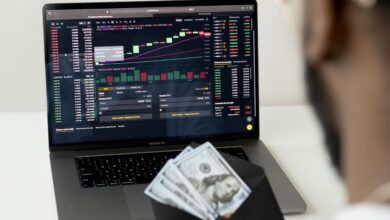Crude Connections: Unraveling the Link Between Oil Prices and Inflation

In an interconnected global economy, few factors exert as profound an influence on financial stability and consumer behavior as oil prices. As the lifeblood of modern industry and transportation, fluctuations in crude oil costs can send ripples through various sectors, affecting everything from manufacturing to consumer goods. This article delves into the intricate relationship between oil prices and inflation, exploring how changes in the cost of this vital resource can sway inflation rates and, by extension, the economic well-being of individuals and nations alike.
In the first section, "Understanding the Dynamics: How Oil Prices Influence Inflation Rates," we will unpack the mechanisms through which oil price shifts impact inflation, examining both direct and indirect channels of influence. Next, "Historical Trends: A Closer Look at Oil Price Fluctuations and Inflationary Pressures" will provide a retrospective analysis of key historical events that illustrate this correlation, highlighting periods of significant price volatility and their corresponding effects on inflation. Finally, in "The Economic Ripple Effect: Implications of Rising Oil Costs on Consumer Prices," we will assess the broader implications of rising oil costs, shedding light on how they ultimately translate into higher prices for everyday goods and services. Through this comprehensive examination, we aim to illuminate the critical connections between oil prices and inflation, offering insights that are increasingly relevant in today's rapidly evolving economic landscape.
- 1. "Understanding the Dynamics: How Oil Prices Influence Inflation Rates"
- 2. "Historical Trends: A Closer Look at Oil Price Fluctuations and Inflationary Pressures"
- 3. "The Economic Ripple Effect: Implications of Rising Oil Costs on Consumer Prices"
1. "Understanding the Dynamics: How Oil Prices Influence Inflation Rates"
Oil prices play a crucial role in shaping inflation rates due to their impact on various sectors of the economy. As a primary energy source, oil influences transportation costs, production expenses, and ultimately, consumer prices. When oil prices rise, the cost of transporting goods and raw materials increases, leading to higher prices for a wide range of products. This phenomenon is particularly evident in industries that heavily rely on oil, such as transportation, manufacturing, and agriculture.
Furthermore, oil prices can affect consumer behavior and spending patterns. Higher fuel costs can reduce disposable income, leading households to cut back on expenditures in other areas. This shift in consumer spending can further exacerbate inflationary pressures, as businesses may respond to decreased sales by raising prices to maintain profit margins.
The relationship between oil prices and inflation is also influenced by expectations. When consumers and businesses anticipate rising oil prices, they may adjust their pricing strategies accordingly. This preemptive action can create a self-fulfilling prophecy, where inflation expectations lead to actual inflation as businesses increase prices to keep up with perceived future costs.
Additionally, central banks monitor oil prices closely, as significant fluctuations can impact monetary policy decisions. For instance, a sharp increase in oil prices may prompt central banks to raise interest rates to counteract inflationary pressures. Conversely, falling oil prices could lead to more accommodative monetary policies, aiming to stimulate economic growth during periods of low inflation.
Overall, the dynamics between oil prices and inflation are complex and multifaceted, influenced by both direct costs and broader economic conditions. Understanding this relationship is essential for policymakers, businesses, and consumers alike, as it can provide insights into future economic trends and inform strategic decision-making.
2. "Historical Trends: A Closer Look at Oil Price Fluctuations and Inflationary Pressures"
Throughout history, the relationship between oil prices and inflation has been both intricate and significant, reflecting broader economic dynamics. From the oil crises of the 1970s to the more recent fluctuations driven by geopolitical tensions and market speculation, oil prices have often served as a barometer for inflationary pressures in various economies.
In the 1970s, the world experienced two major oil shocks—the first in 1973 following the Yom Kippur War and the second in 1979 due to the Iranian Revolution. These events caused oil prices to skyrocket, leading to stagflation in many Western economies, where inflation rates surged while economic growth stagnated. The correlation between rising oil prices and inflation became starkly evident as the cost of energy permeated through various sectors, driving up production costs and, consequently, consumer prices.
Moving into the 21st century, the correlation persisted but evolved. The early 2000s saw a dramatic increase in oil prices, reaching an all-time high of over $140 per barrel in mid-2008. This surge was fueled by a combination of increasing global demand, particularly from emerging economies, and supply constraints. The resultant inflationary pressures were felt globally, with many countries experiencing heightened consumer prices as transportation and production costs rose. However, the subsequent financial crisis of 2008 led to a sharp decline in oil prices, which in many cases alleviated inflationary pressures and even transitioned some economies into deflationary environments.
The following decade brought a new set of challenges, including the rise of shale oil in the United States, which contributed to a new era of fluctuating oil prices. The oil price collapse in 2014, driven by oversupply and geopolitical factors, temporarily alleviated inflation concerns in many developed economies. However, as oil prices recovered in the late 2010s, concerns about inflation resurfaced, particularly as central banks grappled with the implications of rising energy costs on their monetary policies.
The COVID-19 pandemic introduced unprecedented volatility in oil markets. Initially, oil prices plummeted due to decreased demand during lockdowns, leading to deflationary pressures in many countries. However, as economies reopened and demand surged while supply chains struggled to recover, oil prices rebounded sharply in 2021. This resurgence contributed to rising inflation rates globally, as the increased cost of energy fed into broader price increases across various sectors.
In recent years, especially through 2022 and 2023, geopolitical tensions—most notably the conflict involving Ukraine—have once again placed upward pressure on oil prices, reigniting debates about inflation's trajectory. The interplay between oil prices and inflation remains a critical area of analysis for economists and policymakers, as understanding this relationship is vital for navigating the complexities of modern economies. The historical trends demonstrate that while oil price fluctuations can lead to inflationary pressures, the extent and duration of these pressures are often influenced by a myriad of other factors, including monetary policy, global demand dynamics, and supply chain resilience. As such, the ongoing analysis of this correlation will continue to be a key focus in economic discourse.
3. "The Economic Ripple Effect: Implications of Rising Oil Costs on Consumer Prices"
Rising oil costs have a profound economic ripple effect that extends far beyond the energy sector, significantly impacting consumer prices across various goods and services. As oil is a fundamental input for many industries, an increase in oil prices typically leads to higher production and transportation costs. These elevated costs often get passed on to consumers in the form of increased prices for everyday items, from groceries to clothing.
The direct connection between oil prices and inflation is evident in the transportation sector, where fuel costs are a critical component of logistics and supply chain management. When oil prices surge, companies face higher costs for shipping products, which can lead to adjustments in pricing strategies. As businesses strive to maintain profit margins, consumers may experience sticker shock at the checkout line, contributing to an overall increase in the consumer price index (CPI).
Moreover, the impact of rising oil prices can create a psychological effect known as "inflation expectations," where consumers anticipate higher costs and adjust their spending habits accordingly. This shift can lead to a decrease in discretionary spending, as households prioritize essential goods and services, further straining the economy. Additionally, sectors such as travel and hospitality often see immediate repercussions, as increased fuel prices deter consumers from discretionary travel, leading to a slowdown in these industries.
The interplay between rising oil costs and inflation also has broader macroeconomic implications. Central banks may respond to inflationary pressures by adjusting interest rates, which can influence borrowing costs and consumer spending. This, in turn, creates a complex feedback loop where rising oil prices not only affect immediate consumer costs but also shape monetary policy and overall economic growth trajectories.
In summary, the implications of rising oil costs extend well beyond the gas pump, influencing a wide array of consumer prices and economic behavior. Understanding this dynamic is crucial for policymakers and consumers alike, as it underscores the interconnectedness of global markets and the importance of energy prices in the broader economic landscape.
In conclusion, the intricate relationship between oil prices and inflation is both profound and multifaceted. As explored in the various sections of this article, fluctuations in oil prices serve as a significant driver of inflationary pressures, impacting everything from production costs to consumer prices. Historical trends reveal that past oil price shocks have consistently correlated with noticeable spikes in inflation, highlighting the vulnerability of economies reliant on fossil fuels. Furthermore, the economic ripple effect of rising oil costs illustrates the broader implications for consumers and businesses alike, as increased transportation and production expenses are often passed down the supply chain.
As we move forward in an era of economic uncertainty, understanding this correlation becomes increasingly crucial for policymakers, businesses, and consumers. Efforts to diversify energy sources, invest in renewable technologies, and implement sound monetary policies can help mitigate the volatility that comes with oil price fluctuations. Ultimately, recognizing the interconnectedness of oil prices and inflation can empower stakeholders to make more informed decisions, fostering greater resilience in the face of future economic challenges. With ongoing geopolitical tensions and climate change considerations, the dialogue surrounding oil prices and inflation will remain relevant, urging us to stay vigilant and proactive in navigating the complexities of our global economy.





